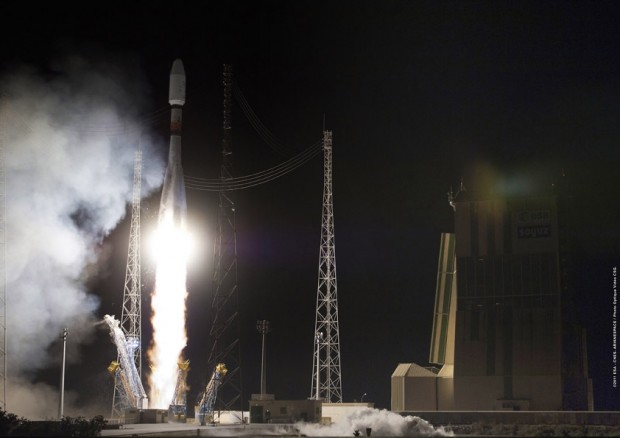Rocket Tracked From Cooper’s Island
A tracking station in Bermuda served as an “ideal location” to track rockets, the French space agency said after a successful launch last month.
In 2011 the European Space Agency (ESA) and the Government of Bermuda signed an agreement which authorized ESA to establish a temporary station on Cooper’s Island to track and receive telemetry data for ESA launch vehicles.
The first launch to be tracked from Bermuda stemming from this agreement took place on December 16th 2011, when the Soyuz rocket was launched from Europe’s Spaceport in French Guiana which is on the north-east coast of South America. The French space agency Centre National d’Etudes Spatiales (CNES) implemented this agreement on behalf of ESA.
The December launch was deemed “successful” because the goal of the launch – which was to place six satellites in orbit at the correct locations, pointing the correct directions and at the correct times – was reached.
“Bermuda is an ideal location to track ESA launch vehicles heading north after liftoff,” explained Michel Starozinski, New Stations Project Manager at CNES.
“We always need a downrange tracking station after the loss of the signal by the Kourou station in Guiana, which occurs about 1,800 km away from the launch pad. When we launch to the North what is the only island after the West Indies between South and North America? Bermuda.”
Mr. Starozinski continued: “This launch, from the T0 (Time Zero) to the end of the mission was particularly long (more than four and a half hours), and during this time, all important phases need to be controlled by the Control Centre. That is why we use several stations to receive, process and transmit in real time the telemetry data sent by the launcher (or ‘rocket’) to the Control Centre in Guiana.
“Telemetry data provides information on the rocket’s trajectory, including its position, velocity and acceleration, and its performance parameters – in particular pressure, temperature, voltage, currents and flight control computer data, as well as main events such as separations of stages and satellites, ignitions and shutdowns of the engines.
“Bermuda was one of the ‘main stations’ during this launch as it was from there that we saw the first ignition of the upper stage of the launcher (Fregat) after its separation and the entire boost of the engine until its shutdown about four minutes later.”
The Cooper’s Island station tracked the launcher during this first pass from the South West on the horizon, about nine minutes after the launch, to the North East at the level of the St David’s lighthouse. About one hour and a half later, the station tracked the launcher for a second pass from the South East to the North East.
Other stations used for this launch were Kourou in French Guiana, Lucknow in India, Jeju in South Korea, Perth in Australia and Saskatoon in Canada.
The Bermuda station at Cooper’s Island consists of a 4.5 meter parabolic antenna, its transport container and a technical shelter to store operational electronic equipment, including a no-break power system, and a power shelter housing two generators and a fuel tank.
These facilities will be rolled out only for the launches set to be tracked from the station and will be removed thereafter. The installation needs about one week and can be done by two or three trained technicians. Two overseas technicians will arrive on the island to dismantle the station at Cooper’s Island next week.
Minister of Environment, Planning and Infrastructure Strategy Marc Bean said: “I am extremely proud of the role Bermuda played recently regarding the success of the Soyuz rocket mission on December 16th – an event which I believe will pave the way for many similar launches to come.
“I am extremely pleased that we could be of assistance to our friends at ESA while, at the same time, being mindful of the sensitive environment we safeguard at Cooper’s Island through the requirement that the tracking station be temporary in nature.
“ESA and the Government of Bermuda will work together to further identify and pursue projects of common interests, in particular the promotion of educational opportunities for students in the country.”
- Photo courtesy of Centre National d’Etudes Spatiales
Read More About
Category: All, Environment, News



So this “third pillar of the economy” creates employment for two or three temporary expats for a week or so every time there’s a launch. They set up the antenna and then take it down.
Sounds like we have that “third leg” of the economy. Yep, boom times are a-comin.
It certainly isn’t “rocket science” to figure that out… (I couldn’t resist).
And it isn’t your dad’s version of Cooper’s Island – unfortunately “suitcase” technology has largely replaced the need for big ugly dish antennas and huge numbers of staff to support them. Even if a permanent installation were to be set up, I can’t see it being that big of a deal – more of a “lock it and leave it” type of installation.
I miss the days of the NASA tracking station… So much history….
I miss the tracking station too. It employed more than expats.